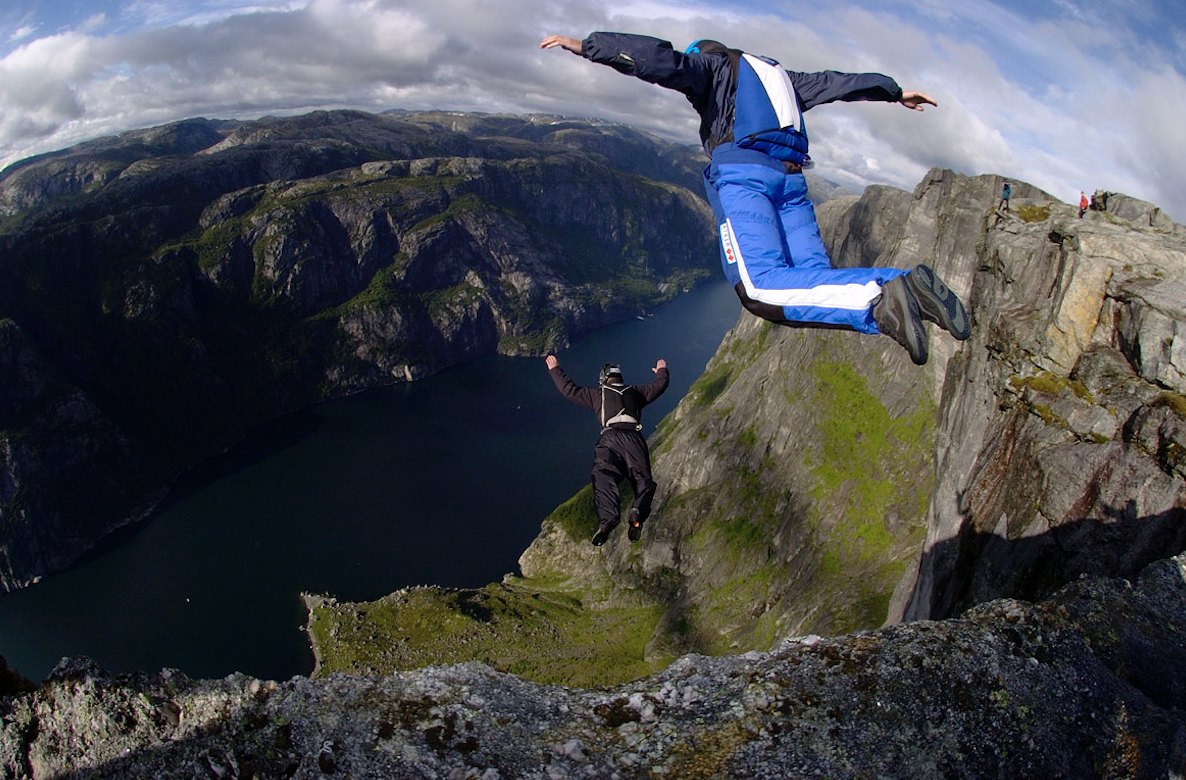Being in danger, understandably, holds a negative connotation in the eyes of many. The idea of unwillingly being placed in a compromising situation in which your health is in peril does not usually comply with our idea of fun. However, it is often overlooked that there exists another type of danger: one where the threat of death is still present, but it is a threat we willingly seek out.
Often referred to as “adrenaline junkies”, those who actively put themselves in dangerous situations for a sport like skydiving or base jumping not only constantly face a threat, but actively look to increase the risk: jumping from a higher height, waiting longer to deploy their safety parachute, or increasing maneuvering difficulty.
The question is, why would we ever willingly put ourselves in danger, or even increase the risk? Take cliff-jumping as an example. When individuals are first introduced to this activity or sport, they start off with a low height and therefore a lower risk. The more comfortable an athlete feels doing one jump, the more comfortable or bored they get of it, in turn motivating them to increase said risk (ie. increasing the height of the jump). The more the cycle is repeated, the higher the risk, until eventually the risk becomes so great that the risk of death is not so abstract anymore.
The reason for this behavior resides in the concept of habituation. This concept explains how being exposed to a certain repeated stimuli for a period of time causes a decreased response to said stimuli. If a beeping noise suddenly plays, the unexpected stimuli will generate a response from you, as you consciously or subconsciously register and react to the sound. But, after a few hours or days, you will become desensitized and tune out the beeping noise.
Habituation offers a number of benefits, primarily consisting of the fact that “habituation has adaptive value in situations where continued response to a constant stimulus would be energetically costly” (Bell, 2012). Psychologists can even use habituation to their advantage to relieve a person of phobias in exposure therapy.
With extreme sports in particular, habituation comes in the form of the reduction of the response to the ‘reward’ of the activity, predominantly dependent on dopamine, a neurotransmitter associated with functions such as but not limited to motivation, learning, and the reward system. With our body being in the fight or flight mode (sympathetic nervous system) when encountering a dangerous situation, dopamine levels in the brain increase, in turn ‘rewarding’ us. However, the more you repeat the activity, the more the tolerance to the reward develops when you predict a high reward. In layman’s terms, if the brain senses that the reward to an activity is greater than expected, dopamine levels will increase, but if the reward is lower than expected, dopamine levels will decrease.
If this occurs in the general population, why are some people more likely to follow through on the increase in risk to achieve the rush of dopamine? Studies found that this depends on whether a person is a high or low sensation-seeking athlete, where high sensation-seekers are more likely to “be hyper-stimulated by novel experiences because their brains release more dopamine during these events than those of low sensation-seekers” (Konkel, 2016).
It is for these reasons that many seek the rush of extreme sports. With the ‘high’ of dopamine, the thrill-seeking characteristics of extreme sports have even been compared to addiction. Shockingly, a 2016 study investigating addiction in extreme sports found that “rock climbing athletes appear to experience withdrawal symptoms when abstinent from their sport comparable to individuals with substance and behavioral addictions”; the climbers experienced anhedonia, cravings, and negative affect. Nonetheless, the benefits of extreme sports can surpass the possible negative effects: not only does participation in such activities help strengthen physical health, it can also relieve stress, increase confidence, and “enhance your fear management skills” (Lifehack, 2016). So if you’d like to go skydiving, go skydiving! Just as long as the benefits outweigh the costs.
Bibliography:
Bell, Alison M, and Harman V S Peeke. “Individual variation in habituation: behaviour over time toward different stimuli in threespine sticklebacks (Gasterosteus aculeatus).” Behaviour vol. 149,13-14 (2012): 1339-1365. doi:10.1163/1568539X-00003019
Cherry, Kendra. “What Does It Mean to Be Habituated to Something?” Verywell Mind, Verywell Mind, 11 May 2022, https://www.verywellmind.com/what-is-habituation-2795233.
De Luca, Maria A. “Habituation of the responsiveness of mesolimbic and mesocortical dopamine transmission to taste stimuli.” Frontiers in integrative neuroscience vol. 8 21. 4 Mar. 2014, doi:10.3389/fnint.2014.00021
Heirene, Robert M et al. “Addiction in Extreme Sports: An Exploration of Withdrawal States in Rock Climbers.” Journal of behavioral addictions vol. 5,2 (2016): 332-41. doi:10.1556/2006.5.2016.039
Konkel, Lindsey. “Extreme Psychology.” Scienceline, 9 Mar. 2016, https://scienceline.org/2009/07/health-konkel-extreme-sports-risk-psychology/.
“9 Great Benefits of Extreme Sports.” Lifehack, 20 Sept. 2016, https://www.lifehack.org/465568/9-great-benefits-of-extreme-sports.


Great job Giulia!